-
Countries
-
Data and Analysis
-
Special Focus
-
Crisis Responses
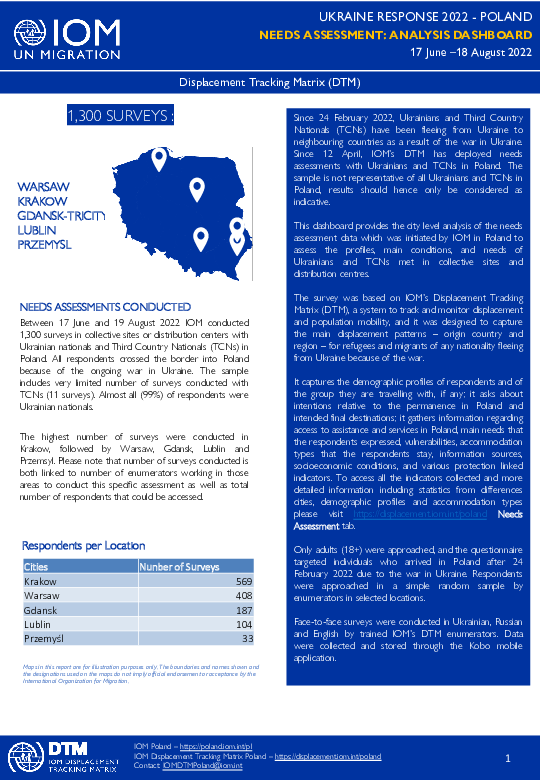
Contact
DTM Europe, DTMMediterranean@iom.int
Language
English
Location
Poland
Period Covered
Jun 17 2022
Aug 18 2022
Activity
- Survey
- Community Perception
This dashboard provides the city level analysis of the needs assessment data which was initiated by IOM in Poland to assess the profiles, main conditions, and needs of Ukrainians and TCNs met in collective sites and distribution centres.

Contact
DTM Cameroon, DTMCameroun@iom.int
Language
English
Location
Cameroon
Period Covered
Oct 09 2022
Oct 11 2022
Activity
- Mobility Tracking
- Event Tracking
Le suivi des situations d’urgence (en anglais, Emergency Tracking Tool, ETT) est une des composantes de la Matrice de suivi des déplacements (DTM) déployée par l’Organisation Internationale pour les Migrations (OIM). Il a pour objectif de rassembler des informations sur les mouvements significatifs et soudains de populations ainsi que sur des urgences sécuritaires et climatiques. Les données ont été collectées par observation directe et par téléphone, auprès des informateurs clés (principalement les autorités locales et les représentants des populations locales). Ce tableau de bord présente des informations sur des mouvements de personnes depuis les localités de Guédjélé, Douval et Oupai, situées dans l’arrondissement de Mayo-Moskota (département du Mayo-Tsanaga) vers la localité de Meliki du Canton Matakan Sud dans l’arrondissement de Mokolo (département de Mayo-Tsanaga), survenus le 07 octobre 2022.

Contact
DTM Cameroon, DTMCameroun@iom.int
Language
English
Location
Cameroon
Period Covered
Oct 13 2022
Oct 13 2022
Activity
- Mobility Tracking
- Event Tracking
Le suivi des situations d’urgence (en anglais, Emergency Tracking Tool, ETT) est une des composantes de la Matrice de suivi des déplacements (DTM) déployée par l’Organisation Internationale pour les Migrations (OIM). Il a pour objectif de rassembler des informations sur les mouvements significatifs et soudains de populations ainsi que sur des urgences sécuritaires et climatiques. Les données ont été collectées par observation directe et par téléphone, auprès de 03 informateurs clés (principalement les autorités locales et les représentants des populations locales) suite au retour progressif des populations après un retour au calme dans le département du Logone et Chari. Ce tableau de bord présente les informations sur les personnes retournées.

Contact
DTM Cameroon, DTMCameroun@iom.int
Language
English
Location
Cameroon
Period Covered
Oct 08 2022
Oct 09 2022
Activity
- Mobility Tracking
- Event Tracking
Le suivi des situations d’urgence (en anglais, Emergency Tracking Tool, ETT) est une des composantes de la Matrice de suivi des déplacements (DTM) déployée par l’Organisation Internationale pour les Migrations (OIM). Il a pour objectif de rassembler des informations sur les mouvements significatifs et soudains de populations ainsi que sur des urgences sécuritaires et climatiques. Les données ont été collectées par observation directe et par téléphone, auprès de 04 informateurs clés (principalement les autorités locales et les représentants de populations sinistrées) dans les lieux affectés. Ce tableau de bord présente les informations sur les personnes affectées par la montée des eaux du fleuve Logone ayant provoqué des inondations et des effondrements des maisons, durant la période du 15 septembre 2022 jusqu’à nos jours. Ainsi, la localité de Danay 1 dans l’arrondissement de Yagoua, département du Mayo Danay, dans la région de l’Extrême-Nord du Cameroun a été victime de ce phénomène.
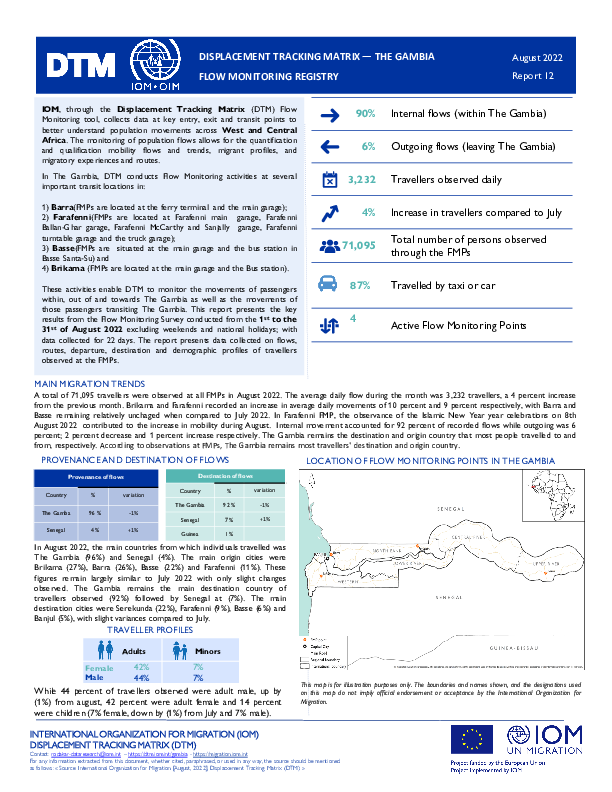
Contact
RO Dakar, RODakar-DataResearch@iom.int
Language
English
Location
The Gambia
Period Covered
Aug 01 2022
Aug 31 2022
Activity
- Flow Monitoring
IOM, through the Displacement Tracking Matrix (DTM) Flow Monitoring tool, collects data at key entry, exit and transit points to better understand population movements across West and Central Africa. The monitoring of population flows allows for the quantification and qualification mobility flows and trends, migrant profiles, and migratory experiences and routes.
In The Gambia, DTM conducts Flow Monitoring activities at several important transit locations in:
1) Barra(FMPs are located at the ferry terminal and the main garage);
2) Farafenni(FMPs are located at Farafenni main garage, Farafenni Ballan-Ghar garage, Farafenni McCarthy and Sanjally garage, Farafenni turntable garage and the truck garage);
3) Basse(FMPs are situated at the main garage and the bus station in Basse Santa-Su) and
4) Brikama (FMPs are located at the main garage and the Bus station).
These activities enable DTM to monitor the movements of passengers within, out of and towards The Gambia as well as the movements of those passengers transiting The Gambia. This report presents the key results from the Flow Monitoring Survey conducted from the 1st to the 31st of August 2022 excluding weekends and national holidays; with data collected for 22 days. The report presents data collected on flows, routes, departure, destination and demographic profiles of travellers observed at the FMPs.

Contact
DTM Europe, DTMMediterranean@iom.int
Language
English
Location
Latvia
Period Covered
Aug 01 2022
Sep 30 2022
Activity
- Survey
- Flow Monitoring
Since 24 February 2022, Ukrainians and Third Country Nationals (TCNs) have been fleeing from Ukraine to neighbouring and other European countries as a result of the war. From the beginning of the war in Ukraine until the the end of September, a total 170,919 Ukrainian nationals were reported at entry through Latvia’s external (non-EU) borders by the Latvian Ministry of Interior, and 39,119 have been registered by Latvian Ministry of Interior (CAK - Civil Support Information Registry). Also, a total of 40,666 have applied for temporary protection in the country as of 30 September.
This report is based on a survey on displacement patterns, needs and intentions launched by IOM’s Displacement Tracking Matrix (DTM). All interviews were conducted face-to-face by IOM’s DTM trained enumerators with adult refugees fleeing Ukraine. This report presents an analysis based on 345 surveys collected between 1 August to 30 September 2022. Data collection was made in 9 different cities; the majority of the surveys (74%) were collected in transit places of the capital Rīga (collective and registration centres, bus and train stations, other open spaces). Another 26 per cent of the surveys were collected in the eastern region of Latgale. In particular, surveys were collected in entry and transit points in Rēzekne (15%), in Zilupe (5%), and other locations close to the border with the Russian Federation.
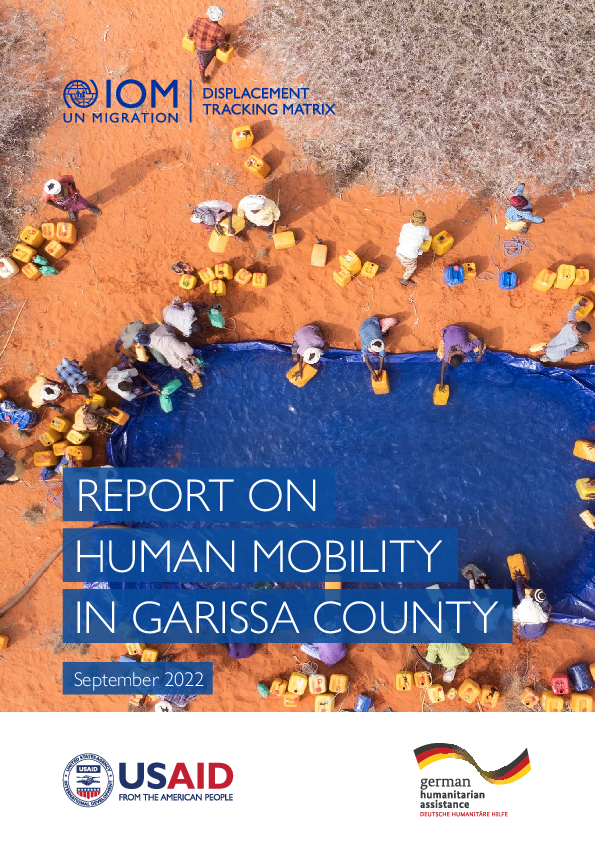
Contact
NBOIM@iom.int
Language
English
Location
Kenya
Period Covered
Sep 05 2022
Sep 19 2022
Activity
- Baseline Assessment
Over the past two years, the drought situation in northeastern Kenya has been deteriorating, resulting in approximately 4.4 million people living in the arid and semi-arid lands of Kenya facing acute food insecurity (IPC Phase 3 and above).1 This is the worst drought in over 40 years2; these severe conditions are a direct result of four consecutive failed rainy seasons in the Horn of Africa region, while the fifth upcoming season is also forecasted to be below average.3 While there is solid and regular monitoring of several indicators linked to the impact of drought through the Long Rains Food Security Assessments and the Short Rains Assessments carried out by the National Drought Management Authority (NDMA) and partners, there is no comprehensive quantitative information on the human mobility dynamics because of drought in Kenya. To this end, and in order to inform the humanitarian response, the International Organization for Migration (IOM), deployed its Displacement Tracking Matrix (DTM) in Garissa County, which is indicated as operational priority 1 for multisectoral needs severity, to provide estimates of population mobility dynamics due to drought.

Contact
dtmhaiti@iom.int
Language
English
Location
Haiti
Period Covered
Sep 24 2022
Sep 30 2022
Activity
- Event Tracking
Une recrudesence des affrontements entre gangs rivaux dans la Zone métropolitaine de Port-au-Prince (ZMPP) au cours des derniers mois a aggravé une situation économique déjà précaire. Cela a contribué à des déplacements urbains à grande échelle. Les tendances existantes ont été accentuées ces dernières semaines en raison de l'agitation généralisée. Ce rapport présente les résultats de l'évaluation hebdomadaire des déplacements et de la situation humanitaire effectuée par le système d'alerte précoce du ZMPP.
353 nouveaux déplacements (-21% par rapport à la période d'évaluation précédente) et 473 nouvelles arrivées (-6% par rapport à la période d'évaluation précédente) de personnes déplacées internes ont été rapportés pendant la période d’évaluation dans les 341 quartiers évalués. La plupart de ces déplacements ont eu lieu dans les communes de Pétion-Ville (43%), Cité Soleil (23%) et Delmas (21%). La situation de sécurité s'est améliorée par rapport à la période d'évaluation précédente grâce à une diminution des manifestations et à une meilleure liberté de circulation. Néanmoins, elle reste toujours tendue, avec 183 quartiers affectés par l'insécurité, 53 par des violences généralisées et 12 par des violences ciblées. Des épisodes violents ont été signalés comme ayant causé la mort de certaines personnes déplacées. 10 quartiers ont été touchés par des inondations, une situation aggravée par le mauvais état des infrastructures de canalisation dans la ZMPP. Durant la période d’évaluation du 17 au 23 septembre, la DTM avait enregistré 445 nouveaux déplacements et 501 nouvelles arrivées de personnes déplacées dans 326 quartiers évalués.
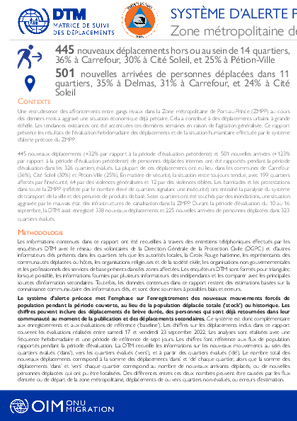
Contact
dtmhaiti@iom.int
Language
English
Location
Haiti
Period Covered
Sep 17 2022
Sep 23 2022
Activity
- Event Tracking
Une recrudesence des affrontements entre gangs rivaux dans la Zone métropolitaine de Port-au-Prince (ZMPP) au cours des derniers mois a aggravé une situation économique déjà précaire. Cela a contribué à des déplacements urbains à grande échelle. Les tendances existantes ont été accentuées ces dernières semaines en raison de l'agitation généralisée. Ce rapport présente les résultats de l'évaluation hebdomadaire des déplacements et de la situation humanitaire effectuée par le système d'alerte précoce du ZMPP.
445 nouveaux déplacements (+32% par rapport à la période d'évaluation précédente) et 501 nouvelles arrivées (+123% par rapport à la période d'évaluation précédente) de personnes déplacées internes ont été rapportés pendant la période d’évaluation dans les 326 quartiers évalués. La plupart de ces déplacements ont eu lieu dans les communes de Carrefour (36%), Cité Soleil (30%) et Pétion-Ville (25%). En matière de sécurité, la situation reste toujours tendue, avec 199 quartiers affectés par l'insécurité, 64 par des violences généralisées et 12 par des violences ciblées. Les barricades et les protestations dans toute la ZMPP (reflétée par le nombre élevé de quartiers signalant une insécurité) ont entraîné la paralysie du système de transport de la ville et des pénuries de produits de base. Seize quartiers ont été touchés par des inondations, une situation aggravée par le mauvais état des infrastructures de canalisation dans la ZMPP. Durant la période d’évaluation du 10 au 16 septembre, la DTM avait enregistré 338 nouveaux déplacements et 225 nouvelles arrivées de personnes déplacées dans 323 quartiers évalués.
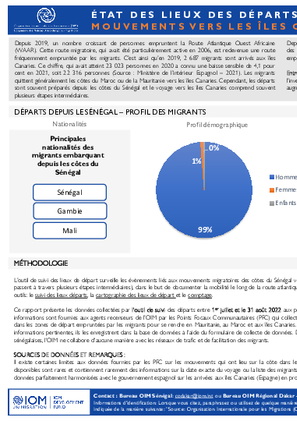
Contact
RO Dakar, RODakar-DataResearch@iom.int,codakar@iom.int
Language
French
Location
Senegal
Period Covered
Jul 01 2022
Aug 31 2022
Activity
- Other
- Flow Monitoring
Depuis 2019, un nombre croissant de personnes empruntent la Route Atlantique Ouest Africaine (WAAR). Cette route migratoire, qui avait été particulièrement active en 2006, est redevenue une route fréquemment empruntée par les migrants. C’est ainsi qu’en 2019, 2 687 migrants sont arrivés aux îles Canaries. Ce chiffre, qui avait atteint 23 023 personnes en 2020 a connu une baisse sensible de 4,1 pour cent en 2021, soit 22 316 personnes (Source : Ministère de l’intérieur Espagnol – 2021). Les migrants quittent généralement les côtes du Maroc ou de la Mauritanie vers les îles Canaries. Cependant, les départs sont souvent préparés depuis les côtes du Sénégal et le voyage vers les îles Canaries comprend souvent plusieurs étapes intermédiaires.
Depuis octobre 2020, l’OIM réalise un monitoring des principaux lieux de départ de bateaux en direction des Îles Canaries (Espagne). Ce rapport présente les principales données collectées, la méthodologie employée et les autres évènements identifiés par les enquêteurs le long des côtes sénégalaises.
Entre janvier et août 2022, 10 637 migrants sont arrivés de manière irrégulière dans les îles Canaries. A l’inverse, au cours de la même période en 2021, on dénombrait 9 255 arrivées. Ceci représente une augmentation de 15 pour cent (Source : Ministère de l’intérieur Espagnol).
